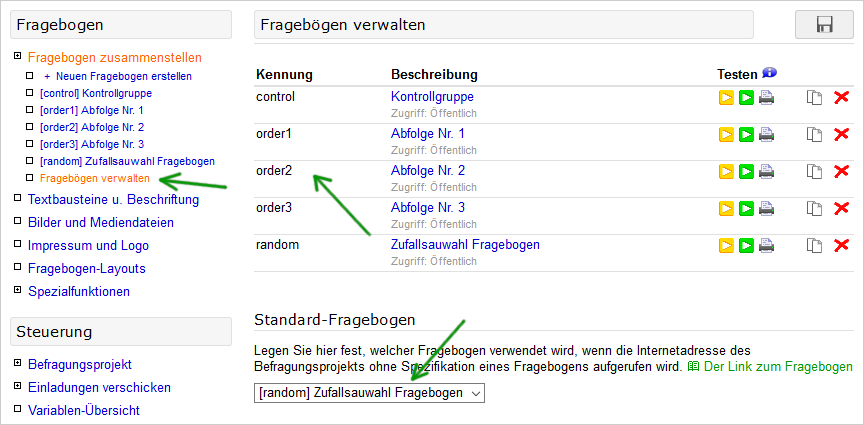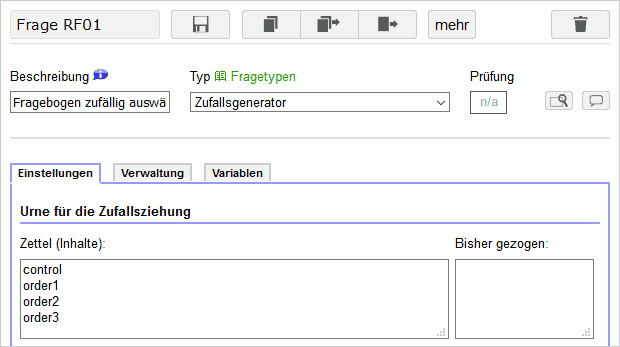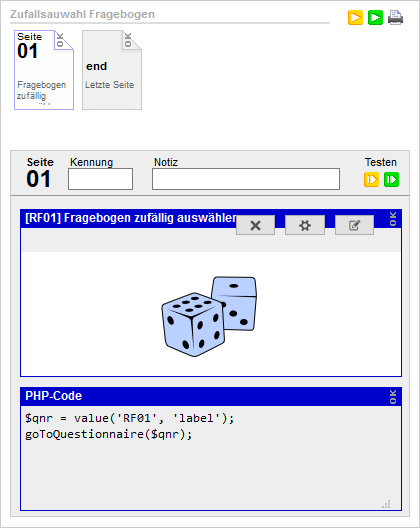- de
- en
Table of Contents
Random Selection for Questionnaires
In a survey project you can create several questionnaires (Assemble Questionnaire) → Create new Questionnaire or Manage Questionnaires). If the participant opens the link to to questionnaire, they can be randomly assigned to one of the questionnaires.
Warning: If you implement randomization across different questionnaires, systematic dropouts can lead to an (sometimes significantly) uneven distribution in the completed questionnaires. Use only a questionnaire with Randomization of the stimulus to reliably fill the experimental groups evenly (see also the following note).
Warning: If the experimental groups work in different questionnaires, it is necessary to pay special attention to ensure that the questionnaires are identical except for the treatment. For example, if a change is made in only one of the questionnaires after the pretest, this can lead to confounding and the inability to use the data. The “normal” Randomization is less error-prone here.
Note: For experiments it is usually much easier (!) to create only one questionnaire and vary the stimulus with a small PHP code (Randomization).
How-to
First you create an additional questionnaire under Assemble Questionnaire → Create new Questionnaire, that takes care of the random assignment. The questionnaire identifier can be chosen freely, for the following description we use the ID “random”.
Define this questionnaire “random” as the default questionnaire under Assemble Questionnaire → Manage Questionnaires.
To ensure an equal distribution of the participants on the questionnaires, you need a question of the type Random Generator. You can create this question in any category – for the further description it is assumed that this question has the ID “RF01”.
Enter the IDs of the questionnaires (see above) you want to choose between as codes in the random generator and save the question ( ).
).
Leave the default setting “equally distributes” selected for the type of drawing. The option “Equally distributed in finished questionnaires” will not work because the random distribution questionnaire will never be finished.
Open the questionnaire that you have created for random distribution under Assemble Questionnaire for editing.
- Drag the random generator (RF01) to the first (and only) page of the questionnaire, and
- place the following PHP code below it.
$qnr = value('RF01', 'label'); goToQuestionnaire($qnr);
The function value() retrieves the ID of the randomly drawn questionnaire from the random generator. The function goToQuestionnaire() jumps directly to the questionnaire with the corresponding ID.
You have chosen the questionnaire “random” under Assemble Questionnaire → Administer Questionnaires as the default questionnaire for the survey project. The participants can call URL to the Questionnaire without further parameters (q=…). They will then first be taken to the “random” questionnaire and from there randomly distributed to one of the other two questionnaires.
Weighted Selection
If some questionnaires should be selected more often than others (higher weighting in the random selection), please simply enter their identifiers several times in the random generator.
The following random generator for example would select te questionaire “control” twice as often as “order1”, “order2” or “order3”.
1 control 2 control 3 order1 4 order2 5 order3
Interaction with extern Panels
If you recrute the respondants from an extern panel you have to transmit respondetcodes in most cases in the redirect: Working with External Panel Providers
As soon as goToQuestionnaire() is used, a new case is created in the dataset. In this (new) interview, it is no longer possible to access the data that were collected in the original questionnaire (here, for example, “random”). This also applies to a participation code that may have been passed via URL from the panel provider.
For the process to work, you have to explicitly pass the participation code to the subordinate interview. Therefore the function multiLevelDown() is used. If the participation code was passed by reference (REF), you would the lines (see above)
$qnr = value('RF01', 'label'); goToQuestionnaire($qnr);
replace with
$qnr = value('RF01', 'label'); multiLevelDown($qnr, reference());
In the subordinate questionnaire you can then access the passed code using multiLevelData(). In the redirect on the penultimate page of the questionnaire, the reference would then no longer be used directly …
redirect('https://www.panelanbieter.de/complete?xyz=ABCDEF&uid=%reference%'); // or equivalent redirect('https://www.panelanbieter.de/complete?xyz=ABCDEF&uid='.reference());
… but instead the data passed by multiLevelDown(), i.e.
redirect('https://www.panelanbieter.de/complete?xyz=ABCDEF&uid='.multiLevelData());
Transfer multiple variables
If other variables are to be transferred in addition to the panel ID, these can be transferred together as Array in multiLevelDown() to the downstream questionnaire.
The following code uses string keys for the variables ('panelID', 'userID' etc.) – this is mainly for better comprehensibility.
// Random selection for a questionnaire $qnr = value('RF01', 'label'); // Summarize data $data = [ 'panelID' => reference(), 'userID' => value('RV01x01'), 'AB01_01' => value('AB01_01'), 'AB01_02' => value('AB01_02') ]; // Transfer data multiLevelDown($qnr, $data);
To subordinate questionnaires, the data can be distributed to individual variables again.
$data = multiLevelData(); put('IV01_01', $data['panelID']); put('IV01_02', $data['userID']); // The filter variables are saved here directly in the filter questions put('AB01_01', $data['AB01_01'], true); put('AB01_02', $data['AB01_02'], true);
The redirect can access the panel ID stored in 'IV01_01'.
redirect('https://www.panelanbieter.de/complete?xyz=ABCDEF&uid='.value('IV01_01'));




